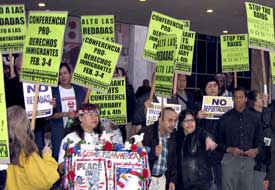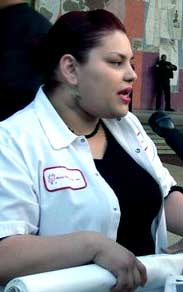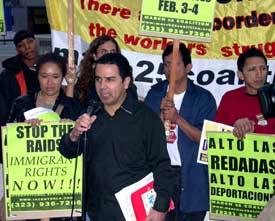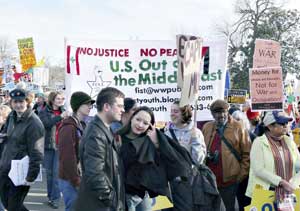2.12.2007
Youth pay price of capitalism’s environmental destruction
The Bush administration’s proposed 2008 budget calls for an extraordinary $2.9 trillion in spending.
A reasonable observer might expect that a budget that huge would allocate sufficient resources to fund the types of programs that would benefit young workers and students: universal higher education and the cancellation of existing student loan debt, job training, and public works programs employing young people to construct much-needed mass transit and energy-efficient affordable housing.
 |
Instead, the Bush budget is designed to finance the escalation of conflict in the Middle East. It provides the Pentagon another $100 billion for the Iraq and Afghanistan wars this year, on top of the $70 billion already allocated by Congress, plus $141.7 billion for these wars next year—all to pay for death and destruction meant to crush opposition to the super-exploitation of the area by the major U.S. and British oil companies.
The total 2008 Pentagon budget, which also includes huge expenditures on costly weapons systems and basing troops around the world, would come to $624.6 billion.
The immediate human impact of the Iraq war is obvious. Over 3,100 U.S. soldiers have died in Iraq so far. Civilian Iraqi casualties of the violence are reported in excess of 60,000. The average age of a dead U.S. soldier in Iraq is less than 27.
The war in Iraq not only affects the young by sapping resources and sending them off to die. It also has dire environmental consequences for those with the longest time left to live on this planet.
The use of depleted uranium (DU), white phosphorus, MK77 Mod 5 napalm and other outlawed incendiary weapons in Iraq has an immediate and devastating effect on the health of soldiers and civilians. The Sierra Club of Canada pointed out as early as 1999 that “the environmental consequences of DU weapons residue will be felt for thousands of years as its decay products continually transform into other hazardous radioactive substances in the uranium decay chain.”
The U.S. economy was long ago deliberately structured to be dependent on oil by an agreement among the oil, rubber and automobile companies to stifle quality mass transit. (Eric Schlosser’s “Fast Food Nation” gives the details.) According to the Energy Information Association, U.S. petroleum consumption now exceeds 20.8 million barrels a day. It’s a perfect example of how, under capitalism, short-term economic growth prevails over long-term sustainability because of the drive for profits.
Most workers across the United States have no access to reliable public transportation and must have cars to get to work, to shop, to have a social life. This takes a toll on the young worker’s pocketbook as gasoline prices remain above $2 a gallon. The environment also suffers as increased travel eats up almost 9.2 million barrels of oil a day.
The Intergovernmental Panel on Climate Change (IPCC) met in Paris at the beginning of February and issued a long-awaited report that finally confirmed, with much scientific data, that human activity is the main factor behind global warming. The IPCC predicted that temperatures will continue to rise by as much as 7.2 degrees Fahrenheit by the end of the century.
Global warming is caused when the concentration of greenhouse gases such as carbon dioxide (CO2) rises and they begin to form a heat-trapping blanket around the Earth. More than half of the CO2 now in the atmosphere comes from the burning of fossil fuels—oil, coal and natural gas. Deforestation is another main contributor to CO2 because trees take in CO2 and put out oxygen.
The history of capitalism is replete with examples of disregard for the environment and the lives of young workers. The industrial revolution saw the creation of marvelous new technologies and laid the material basis for capitalism’s ascendancy around the world. Since the capitalists used these technologies to maximize their profits, widespread pollution resulted.
Manchester, England, in the 19th century was an example of how capitalism’s implementation of technology was ruinous from the beginning. There was no space in this industrial town for gardens or green spaces. The sky was filled with thick smoke that polluted the lungs, clothing and homes of the workers forced to live in the city.
Fifty-seven percent of working-class children there died before they reached the age of five. The average life expectancy for the poor was just 17 years. A government report issued in 1842 left no doubt that many of these deaths were the consequence of severe environmental degradation. The co-founder of scientific socialism, Frederick Engels, wrote about this assault on the workers and the environment in his 1845 book “The Condition of the Working Class in England.”
As capitalism in some countries advanced into modern imperialism, with its territorial division of the world among capitalist powers, modern and frequent warfare also arose.
The first and second world wars saw the redrawing of maps in Africa, the Middle East and Asia by the colonial/imperialist powers. The U.S. later waged ruthless wars against national liberation movements in Vietnam and Korea that were led by communists. And the first Gulf War proved itself just a precursor to the current occupation of Iraq.
The U.S. military says that 617,000 U.S. soldiers died in combat in the 20th century. Most of these soldiers were young and recruited from the working class; many were also from the nationally oppressed.
One of the biggest environmental threats arose out of World War II with the development and use of nuclear weapons by the U.S. government. The bombings of Hiroshima and Nagasaki led to the deaths of an estimated 215,000 Japanese civilians. Black rain fell in some areas following the blast, bringing down radioactive material and creating a secondary source of exposure. Radiation-induced cancers and leukemia resulted along with widespread birth deformities and stillbirths.
The United States’ historical use of nuclear weapons and the recent threats of perpetual warfare under the Bush doctrine have made it necessary for countries such as the Democratic People’s Republic of Korea to develop nuclear technology for self-defense purposes.
U.S. imperialism’s current refusal to tackle the root causes of global warming is just the most recent example of the misuse of modern technology by the ruling class.
Capitalism’s derelict stewardship of the environment points to the necessity for workers and oppressed to control the means of production so that technology can be redirected to meet people’s needs.
There is nothing inherently bad for the environment about the scientific and technological advances made since the industrial revolution. In fact, socialist Cuba shines a bright light on how workers’ control can lead to a more sustainable implementation of modern inventions.
Cuba has fought its way to the forefront of conservation and sustainable development against the backdrop of a brutal U.S.-led blockade of the country. The island nation has made incredible advances in farming techniques, housing construction and energy conservation.
One of Cuba’s most impressive achievements is the development of organic agriculture, beginning in the early 1990s. It successfully combines organically produced fertilizer and crop rotation techniques with modern bio-pesticides that use non-toxic microbial formulations to control pests and increase soil nutrition.
Neighborhood vegetable gardens in cities have reduced the amount of transportation necessary to feed urban areas. Havana, for example, has developed 50,000 community gardens to help feed the city.
Cuba reduced its reliance on oil in transportation by fitting public buses with bike racks and distributing over one million Chinese-made bicycles to the Cuban people. Experimentation with more natural building materials, such as bamboo, for the construction of modern-style homes was developed in response to concerns over the amount of greenhouse gas emissions from traditional construction methods.
Cuba has also integrated environmental education as part of its national curriculum while implementing special conservation programs for mountainous areas.
Young people and students in the United States have been in the vanguard of environmental preservation. It is not unusual that young workers with their whole life ahead of them, many of whom face the question of when or whether to begin raising a family, would look to the future dangers posed by pollution with a sense of moral outrage.
Students played a key role in the establishment of the first Earth Day in 1970 and young people today are involved in a variety of environmental causes. But a key ingredient is often missing. That ingredient is class-consciousness.
Environmental degradation occurs because the capitalists are in charge of technology. Not surprisingly the multinational working class suffers the most from the environmental damage that results.
It is important that militant environmental action not be separated from the broader revolutionary movement for working class power. The campaign for things like clean air, fresh drinking water and sustainable coastal areas should be linked to the workers’ broader economic demands for affordable housing, education, healthcare and living-wage jobs.
The only way for workers to secure these demands for themselves is to organize a political movement to take the power, which is denied them under the plutocracy that the capitalists call democracy. Young workers and students must strive to position themselves at the forefront of this revolutionary working class movement for environmental and social justice.
The writer is an organizer of FIST-Fight Imperialism, Stand Together—youth group. Contact fist@workers.org for more information.
Articles copyright 1995-2007 Workers World. Verbatim copying and distribution of this entire article is permitted in any medium without royalty provided this notice is preserved.
Coalition plans May Day actions
In an historic development in the U.S. immigrant rights struggle, a coalition of national organizations met in Los Angeles on Feb. 3-4 to plan and coordinate the “Great American Boycott II” for May 1.
 Federal Building. " border="0"> Federal Building. " border="0"> Feb. 2 protest in front of Los Angeles Federal Building. WW photo: Dante Strobino |
Called by the March 25 Coalition, initiator of the 2006 May Day actions that brought millions into the streets, the coalition aims to defend immigrant workers and show their power by bringing “business as usual” to a halt across the country on May Day.
William Torres of the coalition described the boycott as “the ultimate fight for dignity and justice.”
After the 2006 actions, the U.S. Immigration and Customs Enforcement Agency (ICE) stepped up vicious raids and deportations in an attempt to stop immigrant workers from organizing.
In one of hundreds of examples, ICE combined union-busting with immigrant worker repression by arresting 21 workers at a North Carolina hog-processing plant on Jan. 24. The raid followed two major protests at the Smithfield plant: one initiated by Latina women to stop harassment over immigration papers, and another led by African-American workers to demand union recognition and Martin Luther King Day as a paid holiday. (Workers World, Feb. 2)
The Smithfield raids came after similar raids on thousands of workers at Swift and Co. meatpacking plants in six states on Dec. 12, 2006, when ICE agents terrorized and arrested workers from Mexico, Guatemala, Honduras, El Salvador, Sudan, Ethiopia and elsewhere.
 taking half the workforce, taking half the workforce,but she joined the Feb. 2 protest. " border="0"> ICE raided this Latina's job, taking half the workforce, but she joined the Feb. 2 protest. WW photo: Cheryl LaBash |
A press conference and demonstration condemning the raids, called by March 25 Coalition organizers on Feb. 2 outside the Los Angeles Federal Building, drew a militant 80 people. Two Latina women from a local factory raided the previous day came and described the brutalization by ICE agents, who had held guns to the heads of workers.
The next day Teresa Gutierrez of the New York May 1 Coalition and the International Action Center emphasized: “This conference gathers the movement to defend immigrant workers—from fighting ICE attacks to changing devastating day-to-day working conditions. By mobilizing in the streets, we defeated the Sensenbrenner bill. Together, we can stop the raids!”
Rep. Jim Sensenbrenner sponsored the racist and punitive H.R. 4437, passed by the U.S. House of Representatives in December 2005. One of its many discriminatory components was the proposed erection of a 700-mile wall along the U.S.-Mexican border. Because of massive worker protest in 2006, the bill died in the U.S. Senate.
Chito Quijano, of the progressive Filipino alliance BAYAN-USA and the California Nurses Association, recounted a call for help from a cousin, a documented worker and 20-year U.S. resident, arrested on a trumped-up charge by ICE and threatened with deportation. Quijano said: “Sensenbrenner was the fire that fed last year’s massive protest. This year, the raids will be the fuel.”
A plenary on “Globalization of Immigrant Labor and Transnational Capitalism” featured Teresa Gutierrez and William Robinson, professor of sociology at the University of California, Santa Barbara, and one of the leading U.S. academic critics of capitalism. Robinson outlined the growth of immigration and repression in the United States over the last 30 years, pointing out that contemporary “transnational capitalism” makes the profits it needs to sustain its existence through the value produced by low-wage labor of immigrants. To keep those profits it must maintain economic, legal and cultural control of immigrant workers.
 demands, "Stop the raids!" " border="0"> demands, "Stop the raids!" " border="0"> March 25 Coalition's William Torres demands, "Stop the raids!" |
Gutierrez highlighted the use of racism to divide the working class in its quest for profits. She cited recent inflammatory remarks by right-winger Pat Buchanan and former National Security Council member Samuel Huntingdon, that project when the United States will cease to have a “European” majority and characterize immigrants as threatening the country’s “national identity.”
Gutierrez posed a crucial question: “How, given the repression against immigrants, can we sustain the magnificent movement begun May Day 2006, and bring unity to the immigrant rights struggle?” She pointed out that the biggest fear of the right wing in the United States was that the immigrant question will cause all workers to question what kind of society the United States will be, and will raise the possibility of working-class unity across all nationalities.
The theme of working-class unity across borders wove through the proceedings. Javier Rodríguez, a March 25 Coalition convener, said: “This conference is significant because it is the first organized national effort to convene the major coalitions and groups that are more to the left, that initiated last year’s May 1 boycott. This is the movement that will attempt to coalesce to establish a historical alliance of Latin@s and African Americans. All the roots are here at this conference, with significant representation from both groups.”
Clarence Thomas, an initiator of the Million Worker March, member of International Longshore Workers Union Local 10 and the Alameda County Central Labor Council’s Executive Board, paid homage to the country and people of Mexico for their support in the historical struggle against U.S. slavery, and called for the absolute right of Mexican@s to travel across the U.S.-Mexican border without reprisals. He noted that on May 1, 2006, in the ports of Los Angeles and Long Beach, immigrant truckers refused to move shipping containers, shutting down 90 percent of the shipping. Those ports handle 40 percent of all container traffic coming into the United States.
Thomas vowed to return to Local 10 to ask that it participate in May 1 in a “meaningful way,” adding, “This is a rank-and-file movement, and that’s what’s keeping it afloat.”
Another emphasis of the conference was on international unity across borders, with a plenary featuring Pablo Franco Hernández of the Unión de Juristas de México and attorney for Oaxacan political prisoners, and Senator José Medina of the PRD (Partido de la Revolución Democrática) of Mexico. Both spoke of the movement against repression in the state of Oaxaca and its importance to the immigrant rights struggle within U.S. borders, tied as both movements are to resisting the misery and death wreaked by forces of capitalist globalization. The Popular Assembly of the People of Oaxaca organized massive demonstrations during 2006 for people-directed political autonomy; the Mexican government mounted violent reprisals, including arrests of Flavio Sosa and other leaders.
Medina called for an immediate end to massive deportations within the United States, and emphasized his opposition to any temporary worker program—“modern slavery to a handful of corporations.”
In a plenary on “History and Analysis of the Immigrant and Civil Rights Movement 1968-2006,” Ché López of the Border Social Forum chronicled the immigrant rights movement in North America from 1848 to the formation of his own organization in 2006, drawing together activists on both sides of the border to internationalize the struggle. He connected the new surge of organizing to a rise in class struggle against the current U.S. imperialist agenda, calling for May 1 to represent millions of immigrant and migrant workers all over the world as International Workers Day: “Social change needs to be created from the bottom, and will be by immigrants.”
Stating “I’m here to say the face of the immigrant rights movement is international,” Vicente Panamá Alba of the May 1 Coalition, New York, affirmed, “We are committed to mobilizing the international working class in New York for May 1.”
A video message from Elvira Arellano brought forward the special oppression and resistance of women immigrant workers. Arellano, founder of La Familia Unida Latina, has been in sanctuary in Chicago for six months in defiance of threatened deportation. She affirmed, “I am not a criminal. I am a mother and a father to my son. I fight so the undocumented people will be respected.”
Speakers and workshops at the conference emphasized the need to highlight the issues of immigrant women, such as their vulnerability to rape, sexual harassment and domestic violence when deportation can be used as a threat. Participants called for greater visibility and representation by women in the struggle, and stressed the leadership and resistance of women. One such leader was María Guardado, a former member of the FMLN, the liberation movement of El Salvador, who praised the conference as “a day to launch a great, important movement that is much needed, as we have to organize against the entire system that is the enemy of us all.”
National and transnational action reports and report-backs from the workshops including statements from religious leaders. Mohammed Hanif, imam with the Muslim American Society Freedom Foundation, vowed support, saying, “We are all brothers and sisters, to live together and fight together.” Bishop Filipe C. Teixeira, OFSJC, originally of Angola, said, “As a religious leader, as an immigrant man, I find in this conference ... unity with my brothers and sisters who are struggling.”
Northern California organizer Evelina Molina reminded workshop participants, “The farm worker movement was a class struggle. Let’s name this movement for what it is: a class struggle!” Molina helped organize 40,000 in May 2006 with KBBF’s “Voice of the Worker” in Santa Rosa—the first community-based non-profit Spanish language radio station, which celebrated 35 years in 2006.
Leon Waters of the People’s Hurricane Relief Fund drew the connections between the immigrant rights struggle and that of people displaced internally, like the survivors of Hurricane Katrina.
Walter Sinche from Pachamama Ecuadorian Organizations stated that the rights of Indigenous people throughout the Americas must be raised in the immigrant rights struggle. Sinche said he will march on May Day because it “is better to lose your job than your dignity.”
The need to close the disconnect between the anti-war movement and the immigration struggle and to educate the anti-war movement on the “other wars” in the United States, as well as the need for the immigrant rights struggle to endorse anti-war actions, was part of the report-back from the “U.S. Wars, Iraq and Immigration” workshop by Dianne Mathiowetz of the International Action Center-Atlanta.
Participating groups and organizations included Chispa, ELAC, Students for Immigrant Rights, APALC, South Asian Network, Korea Truth Commission, Hands Off Public Housing-New Orleans, Coalición de Derechos Humanos, Committee for Justice for Héctor Rivas, Mujeres Unidas Y Activas, Comité Pro-Amnistía Y Justicia Social, Jobs with Justice, TIGRA, Voices Crossing Frontiers/Voces Cruzando Fronteras, Unión del Barrio, P.U.E.B.L.O., UCLA Labor Center, IBT 808, U.S.-Cuba Labor Exchange, SEIU 660, Bay Area Teamsters, FIST—Fight Imperialism, Stand Together, National Lawyers Guild, Sex Workers Across Borders, Workers World Party, Freedom Socialist Party, World Can’t Wait, and Peace & Freedom Party.
The conference closed with agreement on the points of unity and recommendations for action.
A statement by Emma Lozano, Director of the Chicago-based Sin Fronteras/La Familia Latina Unida, was given to each participant. It read in part: “Even the best spokespeople in Congress call our people lawbreakers and say we must go to the back of the line. ... While they debate, we must demand a moratorium! We must resist. ... We must join in the boycott!”
Fernando Ledezma, a teacher and member of United Teachers Los Angeles, said, “Martin Luther King spoke of ‘content of character’ and I think it is critical to measure people not by what they are worth in money, but by how they contribute toward society. May 1 will be a celebration of measuring people by the content of their character.”
John Parker from the March 25 Coalition commented about the conference, “This is a great beginning towards building a strong and united movement towards May 1, 2007 that could stop the raids and deportations and make a significant contribution to the struggle to win full legalization rights for all workers. And, given the makeup of labor, immigrant rights, social justice and anti-war organizations that participated in this conference a great contribution to unity and strength has been made.”
Articles copyright 1995-2007 Workers World. Verbatim copying and distribution of this entire article is permitted in any medium without royalty provided this notice is preserved.
New FIST chapter fights bigotry
Baldwin-Wallace College, a small liberal arts school near Cleveland, has recently been the site of major racist attacks. Two Black students living in an all-girl dormitory opened their door one afternoon to find the N-word scribbled on it. As a result, the college held a “forum” and publicly denounced the action.
 |
The very next day, the same epithet, followed by the word “lover,” was scrawled on the door of the resident assistant, who reported the attack. The term has long been used by racists to characterize white people who defend people of color.
The college again publicly denounced the act with statements, but the attacks went on. They dropped the racial language but repeated verbal abuse of the resident assistant, using a word insulting women and telling her to “Get out.”
A few of the young women living in the dorm transferred to other colleges out of a desire not to be forced to tolerate this kind of bigotry.
The Black Student Alliance, a strong organization at Baldwin-Wallace, took action. Members of the alliance called the media. Soon local television crews were interviewing the leaders of the BSA, who called for justice.
The BSA at Baldwin-Wallace College has a strong history of defiance. In years past, it won a cultural center and additional funding for students of color on campus after a sit-in at the president’s office.
The recent attacks provoked loads of outrage around the campus, but it soon simmered down. However, the attacks against the resident assistant continued.
The college administration repeatedly promised to put in video cameras to catch the perpetrators, a promise that never materialized.
This is not an isolated incident at Baldwin-Wallace. Students organizing for the World Can’t Wait campaign often found their literature and postings crumpled up or defaced with phrases like “Go Bush!” or “Bomb the —-!”—using a racist term for Muslims.
Recently a dorm where many members of the LGBT community lived had homophobic words painted on the wall.
In light of all this, several students at Baldwin-Wallace have decided to start a chapter of Fight Imperialism Stand Together (FIST).
Explaining their goal, they say, “We hope to bring together the struggles of people of color and the LGBT community, as well as the many other students from the working class on campus. We hope to show that unity is key to defeating racism, sexism, homophobia and classism. We hope to show the students that their real enemies are not people with a different skin color, nationality or sexual identity, but rather those who inhabit Wall Street and Washington, D.C.”
Articles copyright 1995-2007 Workers World. Verbatim copying and distribution of this entire article is permitted in any medium without royalty provided this notice is preserved.
FIST youth join protest
Scores of youth and student activists from around the country joined the FIST (Fight Imperialism Stand Together) contingent at the Jan. 27 mass anti-war convergence on Washington, D.C.
 WW photo: G. Dunkel |
FIST protested alongside thousands of other young people in a youth feeder march that began with a rally at the Smithsonian and ended in a united march around the Capitol.
Activists from over half a dozen cities, including Cleveland, Philadelphia, New York, New Brunswick, N.J., Raleigh, N.C., and Washington, joined the FIST contingent.
FIST activist Namibia Donadio organized about a dozen students from Rutgers University to attend the march, including several members of the Central and South American Alliance on campus.
Raleigh FIST organizers Peter Gilbert, Dante Strobino and Ben Carroll brought more than 80 students and working young people from the Raleigh-Durham-Chapel Hill triangle in North Carolina. Local activists from the newly refounded Students for a Democratic Society (SDS) also participated in the youth feeder march.
The youth distributed FIST leaflets, flyers for the Feb. 17 national day of actions called by the Troops Out Now Coalition and the March 17 united march on the Pentagon, and copies of Workers World newspaper to thousands of young people from around the country.
Many FIST members participated in a youth breakaway march. This bloc, made up mostly of anarchists and FIST cadre, engaged in a non-permitted march to a military recruiting center in the heart of D.C. to protest the lies that military recruiters tell young people and students, especially the working poor and people of color, in order to enlist them in imperialist wars such as those now raging in Iraq and Afghanistan.
After being violently dispersed from the recruiting center by police, the protesters continued to march through the streets, eventually meeting up with more FIST cadre who joined them on their march back to the Capitol.
The non-permitted march blocked traffic as police issued warnings over loudspeakers for demonstrators to return to the sidewalks. Car drivers and their passengers, however, honked and cheered the protesters on, often raising a clenched fist in the air to demonstrate support for ending the war.
Observers on the sidewalk clapped and shouted words of encouragement and several took time out to resist the police orders and march in the street themselves.
Articles copyright 1995-2007 Workers World. Verbatim copying and distribution of this entire article is permitted in any medium without royalty provided this notice is preserved.



